Financial Management: Analysis of Key Decisions and Shareholder Wealth
VerifiedAdded on 2020/11/23
|7
|1541
|92
Report
AI Summary
This report delves into the core of financial management, emphasizing its role in planning and controlling a company's finances to achieve its objectives, specifically wealth maximization for shareholders. It meticulously examines the three pivotal financial decisions: financing, investment, and dividend decisions, detailing their purposes and implications. The report explores how financing decisions, concerning capital structure, impact shareholders through interest rates and market value. Investment decisions are analyzed for their influence on risk, return, and efficient resource allocation. Dividend decisions are assessed for their effect on shareholder returns and share value. Furthermore, the report highlights the factors within each decision that directly affect a shareholder's financial position, such as debt levels, project profitability, and dividend stability. The conclusion underscores the importance of effective financial management in making optimal decisions to maximize profits and enhance shareholder wealth, ultimately improving the company's overall image.

Financial Management
Paraphrase This Document
Need a fresh take? Get an instant paraphrase of this document with our AI Paraphraser
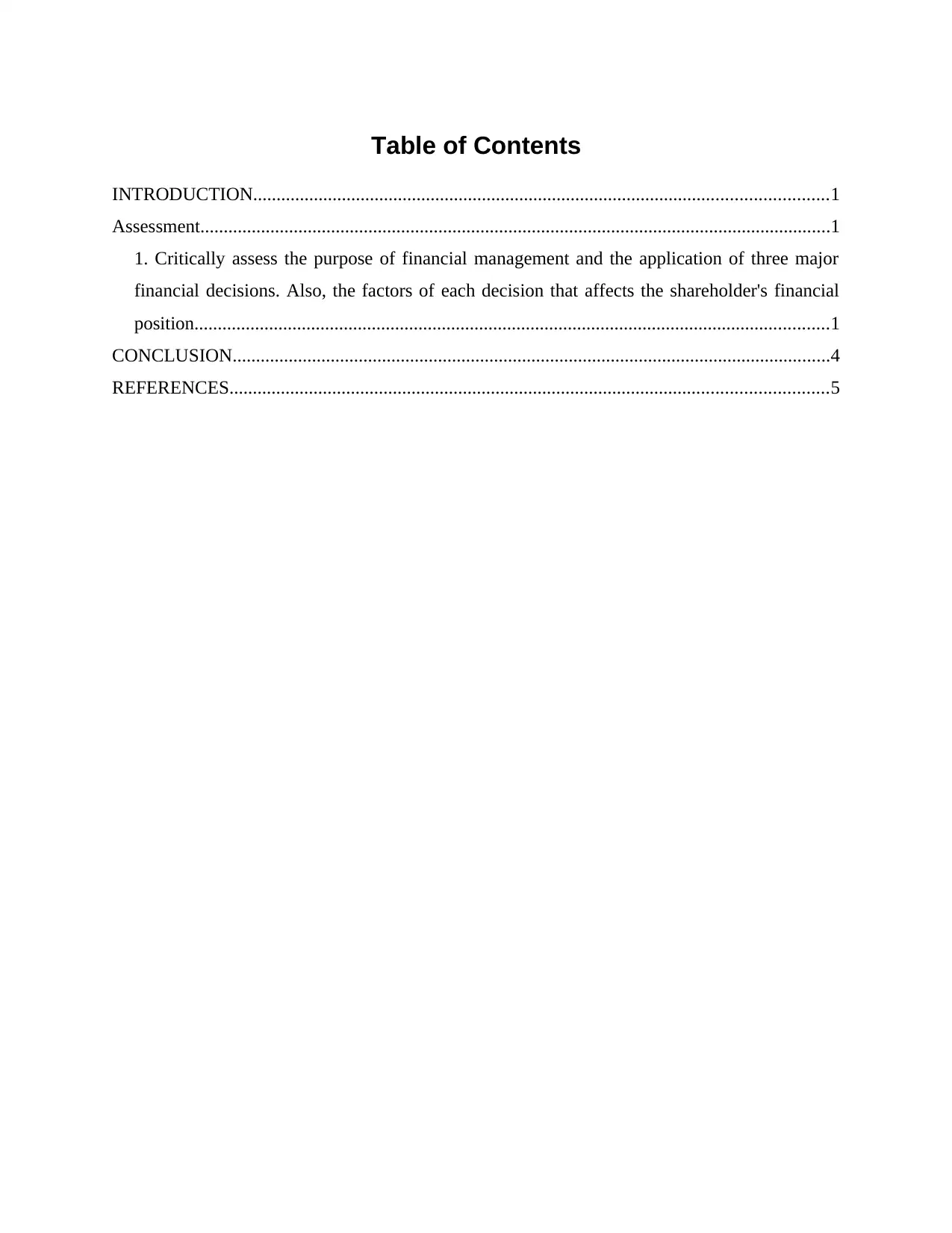
Table of Contents
INTRODUCTION...........................................................................................................................1
Assessment.......................................................................................................................................1
1. Critically assess the purpose of financial management and the application of three major
financial decisions. Also, the factors of each decision that affects the shareholder's financial
position........................................................................................................................................1
CONCLUSION................................................................................................................................4
REFERENCES................................................................................................................................5
INTRODUCTION...........................................................................................................................1
Assessment.......................................................................................................................................1
1. Critically assess the purpose of financial management and the application of three major
financial decisions. Also, the factors of each decision that affects the shareholder's financial
position........................................................................................................................................1
CONCLUSION................................................................................................................................4
REFERENCES................................................................................................................................5
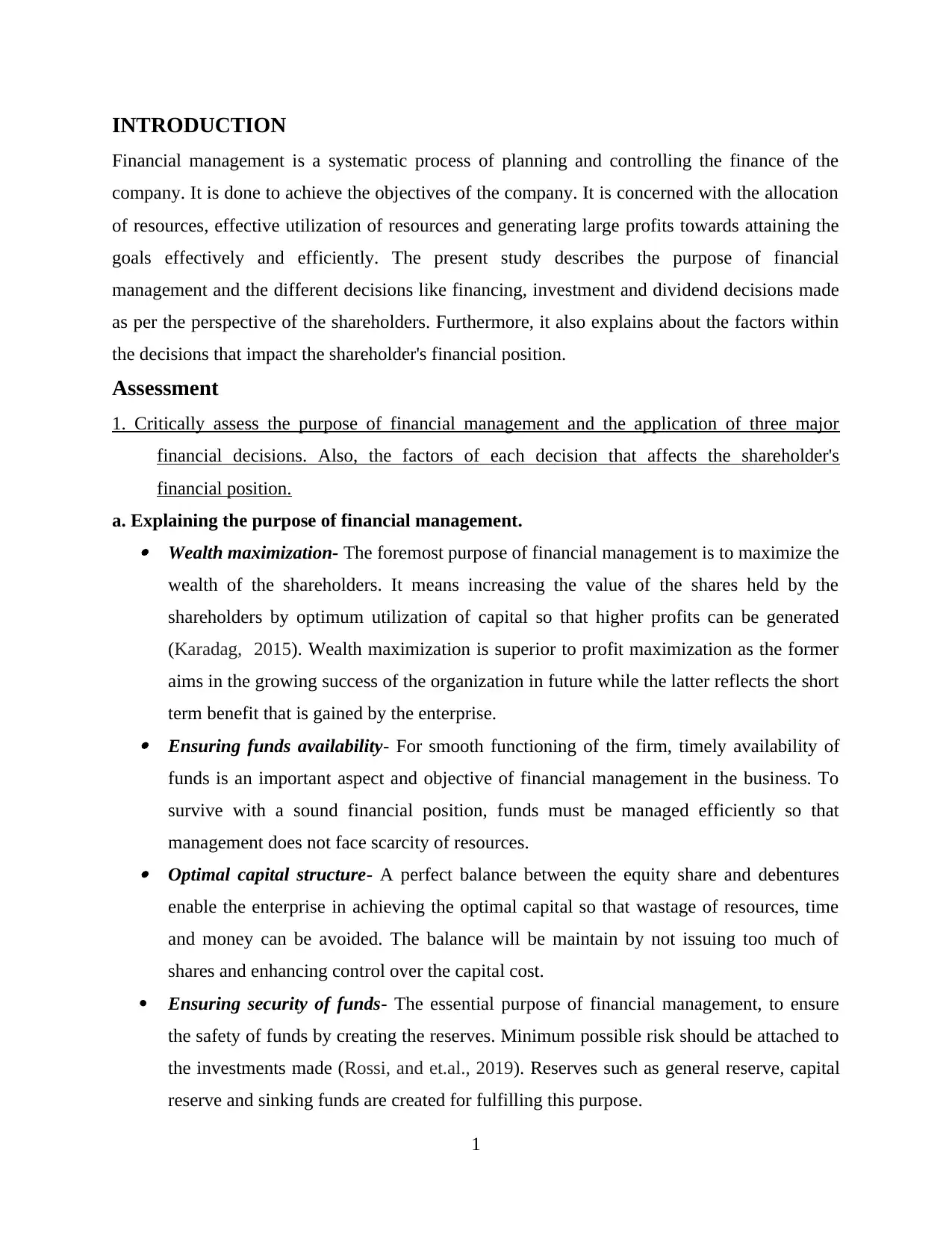
INTRODUCTION
Financial management is a systematic process of planning and controlling the finance of the
company. It is done to achieve the objectives of the company. It is concerned with the allocation
of resources, effective utilization of resources and generating large profits towards attaining the
goals effectively and efficiently. The present study describes the purpose of financial
management and the different decisions like financing, investment and dividend decisions made
as per the perspective of the shareholders. Furthermore, it also explains about the factors within
the decisions that impact the shareholder's financial position.
Assessment
1. Critically assess the purpose of financial management and the application of three major
financial decisions. Also, the factors of each decision that affects the shareholder's
financial position.
a. Explaining the purpose of financial management. Wealth maximization- The foremost purpose of financial management is to maximize the
wealth of the shareholders. It means increasing the value of the shares held by the
shareholders by optimum utilization of capital so that higher profits can be generated
(Karadag, 2015). Wealth maximization is superior to profit maximization as the former
aims in the growing success of the organization in future while the latter reflects the short
term benefit that is gained by the enterprise. Ensuring funds availability- For smooth functioning of the firm, timely availability of
funds is an important aspect and objective of financial management in the business. To
survive with a sound financial position, funds must be managed efficiently so that
management does not face scarcity of resources. Optimal capital structure- A perfect balance between the equity share and debentures
enable the enterprise in achieving the optimal capital so that wastage of resources, time
and money can be avoided. The balance will be maintain by not issuing too much of
shares and enhancing control over the capital cost.
Ensuring security of funds- The essential purpose of financial management, to ensure
the safety of funds by creating the reserves. Minimum possible risk should be attached to
the investments made (Rossi, and et.al., 2019). Reserves such as general reserve, capital
reserve and sinking funds are created for fulfilling this purpose.
1
Financial management is a systematic process of planning and controlling the finance of the
company. It is done to achieve the objectives of the company. It is concerned with the allocation
of resources, effective utilization of resources and generating large profits towards attaining the
goals effectively and efficiently. The present study describes the purpose of financial
management and the different decisions like financing, investment and dividend decisions made
as per the perspective of the shareholders. Furthermore, it also explains about the factors within
the decisions that impact the shareholder's financial position.
Assessment
1. Critically assess the purpose of financial management and the application of three major
financial decisions. Also, the factors of each decision that affects the shareholder's
financial position.
a. Explaining the purpose of financial management. Wealth maximization- The foremost purpose of financial management is to maximize the
wealth of the shareholders. It means increasing the value of the shares held by the
shareholders by optimum utilization of capital so that higher profits can be generated
(Karadag, 2015). Wealth maximization is superior to profit maximization as the former
aims in the growing success of the organization in future while the latter reflects the short
term benefit that is gained by the enterprise. Ensuring funds availability- For smooth functioning of the firm, timely availability of
funds is an important aspect and objective of financial management in the business. To
survive with a sound financial position, funds must be managed efficiently so that
management does not face scarcity of resources. Optimal capital structure- A perfect balance between the equity share and debentures
enable the enterprise in achieving the optimal capital so that wastage of resources, time
and money can be avoided. The balance will be maintain by not issuing too much of
shares and enhancing control over the capital cost.
Ensuring security of funds- The essential purpose of financial management, to ensure
the safety of funds by creating the reserves. Minimum possible risk should be attached to
the investments made (Rossi, and et.al., 2019). Reserves such as general reserve, capital
reserve and sinking funds are created for fulfilling this purpose.
1
⊘ This is a preview!⊘
Do you want full access?
Subscribe today to unlock all pages.

Trusted by 1+ million students worldwide
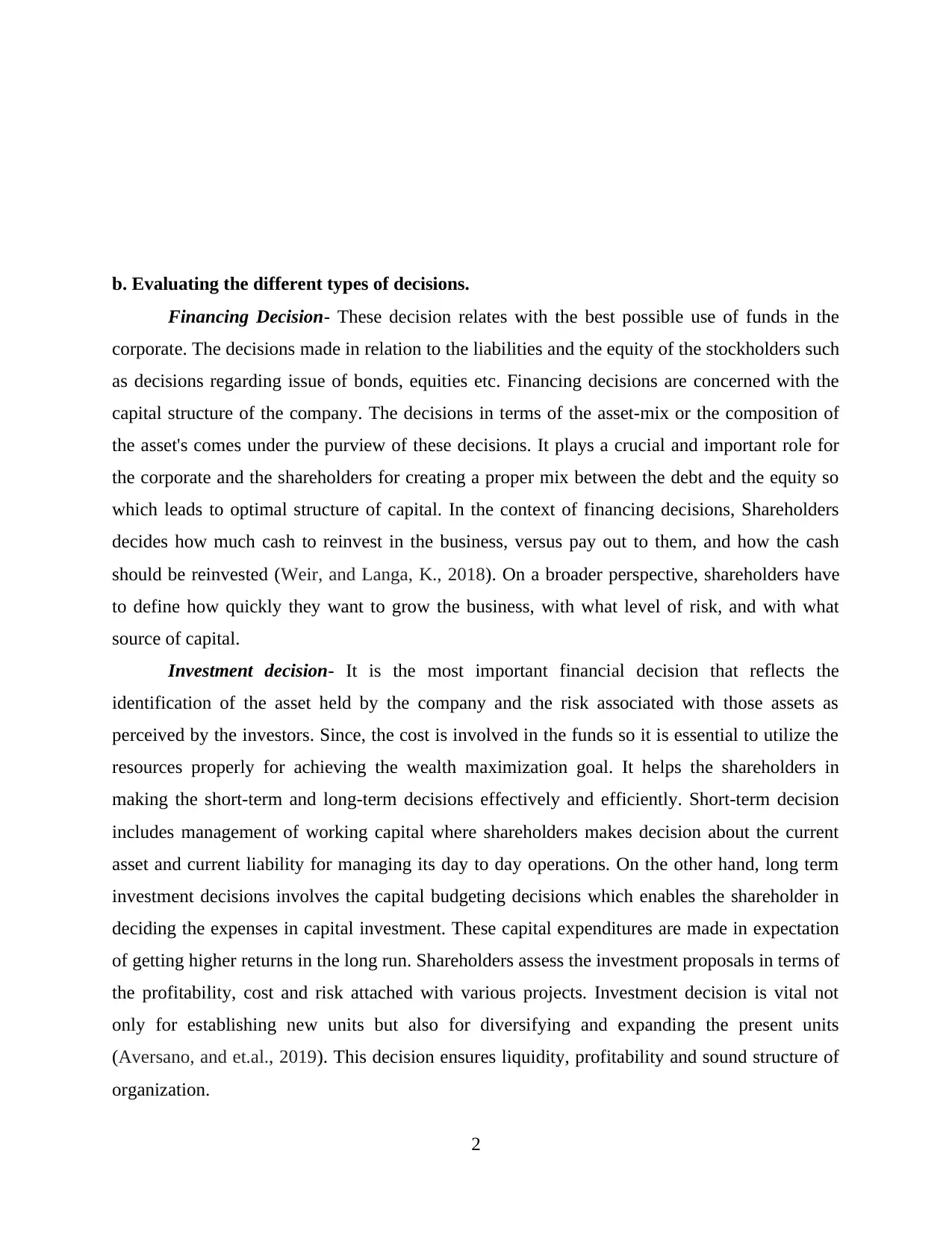
b. Evaluating the different types of decisions.
Financing Decision- These decision relates with the best possible use of funds in the
corporate. The decisions made in relation to the liabilities and the equity of the stockholders such
as decisions regarding issue of bonds, equities etc. Financing decisions are concerned with the
capital structure of the company. The decisions in terms of the asset-mix or the composition of
the asset's comes under the purview of these decisions. It plays a crucial and important role for
the corporate and the shareholders for creating a proper mix between the debt and the equity so
which leads to optimal structure of capital. In the context of financing decisions, Shareholders
decides how much cash to reinvest in the business, versus pay out to them, and how the cash
should be reinvested (Weir, and Langa, K., 2018). On a broader perspective, shareholders have
to define how quickly they want to grow the business, with what level of risk, and with what
source of capital.
Investment decision- It is the most important financial decision that reflects the
identification of the asset held by the company and the risk associated with those assets as
perceived by the investors. Since, the cost is involved in the funds so it is essential to utilize the
resources properly for achieving the wealth maximization goal. It helps the shareholders in
making the short-term and long-term decisions effectively and efficiently. Short-term decision
includes management of working capital where shareholders makes decision about the current
asset and current liability for managing its day to day operations. On the other hand, long term
investment decisions involves the capital budgeting decisions which enables the shareholder in
deciding the expenses in capital investment. These capital expenditures are made in expectation
of getting higher returns in the long run. Shareholders assess the investment proposals in terms of
the profitability, cost and risk attached with various projects. Investment decision is vital not
only for establishing new units but also for diversifying and expanding the present units
(Aversano, and et.al., 2019). This decision ensures liquidity, profitability and sound structure of
organization.
2
Financing Decision- These decision relates with the best possible use of funds in the
corporate. The decisions made in relation to the liabilities and the equity of the stockholders such
as decisions regarding issue of bonds, equities etc. Financing decisions are concerned with the
capital structure of the company. The decisions in terms of the asset-mix or the composition of
the asset's comes under the purview of these decisions. It plays a crucial and important role for
the corporate and the shareholders for creating a proper mix between the debt and the equity so
which leads to optimal structure of capital. In the context of financing decisions, Shareholders
decides how much cash to reinvest in the business, versus pay out to them, and how the cash
should be reinvested (Weir, and Langa, K., 2018). On a broader perspective, shareholders have
to define how quickly they want to grow the business, with what level of risk, and with what
source of capital.
Investment decision- It is the most important financial decision that reflects the
identification of the asset held by the company and the risk associated with those assets as
perceived by the investors. Since, the cost is involved in the funds so it is essential to utilize the
resources properly for achieving the wealth maximization goal. It helps the shareholders in
making the short-term and long-term decisions effectively and efficiently. Short-term decision
includes management of working capital where shareholders makes decision about the current
asset and current liability for managing its day to day operations. On the other hand, long term
investment decisions involves the capital budgeting decisions which enables the shareholder in
deciding the expenses in capital investment. These capital expenditures are made in expectation
of getting higher returns in the long run. Shareholders assess the investment proposals in terms of
the profitability, cost and risk attached with various projects. Investment decision is vital not
only for establishing new units but also for diversifying and expanding the present units
(Aversano, and et.al., 2019). This decision ensures liquidity, profitability and sound structure of
organization.
2
Paraphrase This Document
Need a fresh take? Get an instant paraphrase of this document with our AI Paraphraser
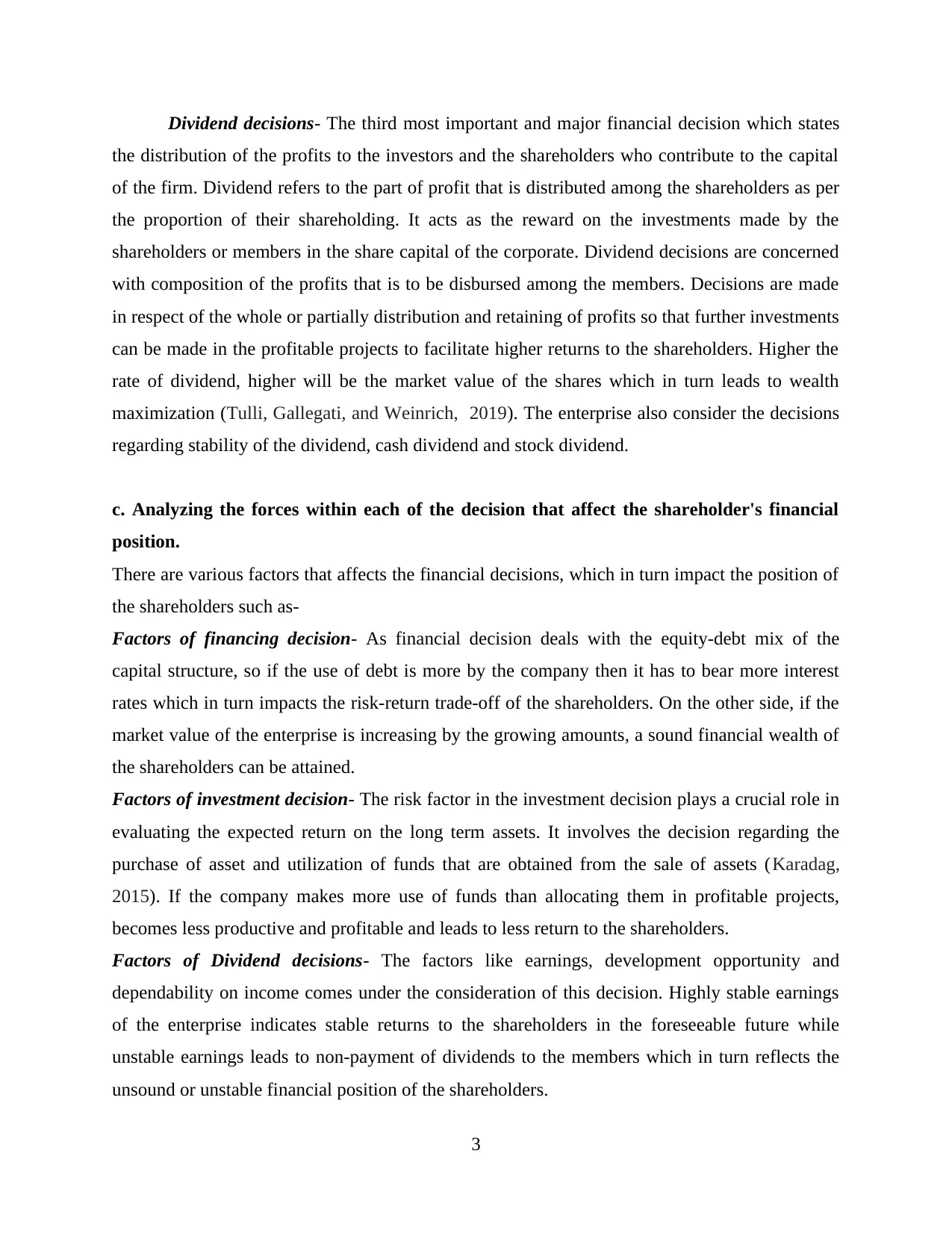
Dividend decisions- The third most important and major financial decision which states
the distribution of the profits to the investors and the shareholders who contribute to the capital
of the firm. Dividend refers to the part of profit that is distributed among the shareholders as per
the proportion of their shareholding. It acts as the reward on the investments made by the
shareholders or members in the share capital of the corporate. Dividend decisions are concerned
with composition of the profits that is to be disbursed among the members. Decisions are made
in respect of the whole or partially distribution and retaining of profits so that further investments
can be made in the profitable projects to facilitate higher returns to the shareholders. Higher the
rate of dividend, higher will be the market value of the shares which in turn leads to wealth
maximization (Tulli, Gallegati, and Weinrich, 2019). The enterprise also consider the decisions
regarding stability of the dividend, cash dividend and stock dividend.
c. Analyzing the forces within each of the decision that affect the shareholder's financial
position.
There are various factors that affects the financial decisions, which in turn impact the position of
the shareholders such as-
Factors of financing decision- As financial decision deals with the equity-debt mix of the
capital structure, so if the use of debt is more by the company then it has to bear more interest
rates which in turn impacts the risk-return trade-off of the shareholders. On the other side, if the
market value of the enterprise is increasing by the growing amounts, a sound financial wealth of
the shareholders can be attained.
Factors of investment decision- The risk factor in the investment decision plays a crucial role in
evaluating the expected return on the long term assets. It involves the decision regarding the
purchase of asset and utilization of funds that are obtained from the sale of assets (Karadag,
2015). If the company makes more use of funds than allocating them in profitable projects,
becomes less productive and profitable and leads to less return to the shareholders.
Factors of Dividend decisions- The factors like earnings, development opportunity and
dependability on income comes under the consideration of this decision. Highly stable earnings
of the enterprise indicates stable returns to the shareholders in the foreseeable future while
unstable earnings leads to non-payment of dividends to the members which in turn reflects the
unsound or unstable financial position of the shareholders.
3
the distribution of the profits to the investors and the shareholders who contribute to the capital
of the firm. Dividend refers to the part of profit that is distributed among the shareholders as per
the proportion of their shareholding. It acts as the reward on the investments made by the
shareholders or members in the share capital of the corporate. Dividend decisions are concerned
with composition of the profits that is to be disbursed among the members. Decisions are made
in respect of the whole or partially distribution and retaining of profits so that further investments
can be made in the profitable projects to facilitate higher returns to the shareholders. Higher the
rate of dividend, higher will be the market value of the shares which in turn leads to wealth
maximization (Tulli, Gallegati, and Weinrich, 2019). The enterprise also consider the decisions
regarding stability of the dividend, cash dividend and stock dividend.
c. Analyzing the forces within each of the decision that affect the shareholder's financial
position.
There are various factors that affects the financial decisions, which in turn impact the position of
the shareholders such as-
Factors of financing decision- As financial decision deals with the equity-debt mix of the
capital structure, so if the use of debt is more by the company then it has to bear more interest
rates which in turn impacts the risk-return trade-off of the shareholders. On the other side, if the
market value of the enterprise is increasing by the growing amounts, a sound financial wealth of
the shareholders can be attained.
Factors of investment decision- The risk factor in the investment decision plays a crucial role in
evaluating the expected return on the long term assets. It involves the decision regarding the
purchase of asset and utilization of funds that are obtained from the sale of assets (Karadag,
2015). If the company makes more use of funds than allocating them in profitable projects,
becomes less productive and profitable and leads to less return to the shareholders.
Factors of Dividend decisions- The factors like earnings, development opportunity and
dependability on income comes under the consideration of this decision. Highly stable earnings
of the enterprise indicates stable returns to the shareholders in the foreseeable future while
unstable earnings leads to non-payment of dividends to the members which in turn reflects the
unsound or unstable financial position of the shareholders.
3
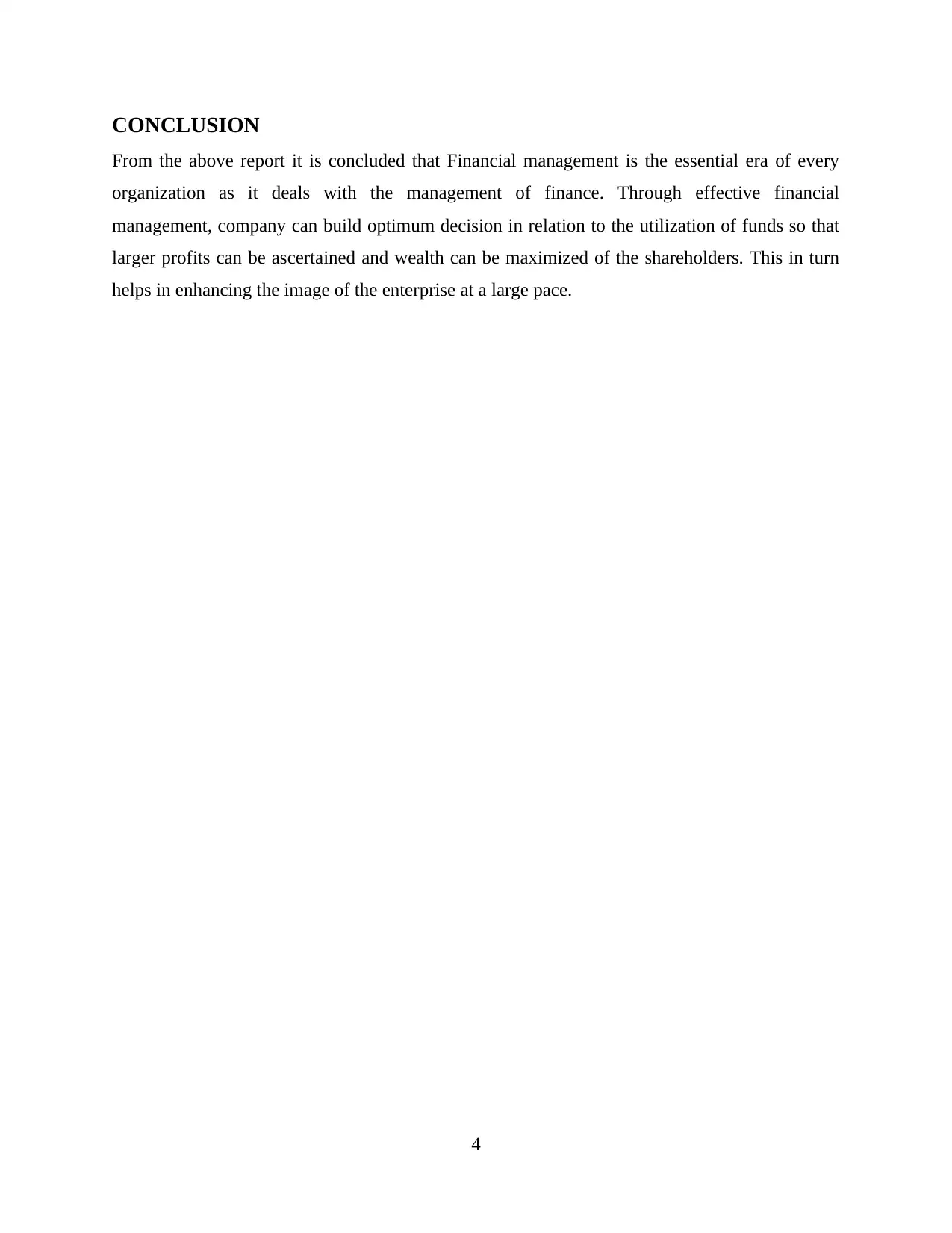
CONCLUSION
From the above report it is concluded that Financial management is the essential era of every
organization as it deals with the management of finance. Through effective financial
management, company can build optimum decision in relation to the utilization of funds so that
larger profits can be ascertained and wealth can be maximized of the shareholders. This in turn
helps in enhancing the image of the enterprise at a large pace.
4
From the above report it is concluded that Financial management is the essential era of every
organization as it deals with the management of finance. Through effective financial
management, company can build optimum decision in relation to the utilization of funds so that
larger profits can be ascertained and wealth can be maximized of the shareholders. This in turn
helps in enhancing the image of the enterprise at a large pace.
4
⊘ This is a preview!⊘
Do you want full access?
Subscribe today to unlock all pages.

Trusted by 1+ million students worldwide
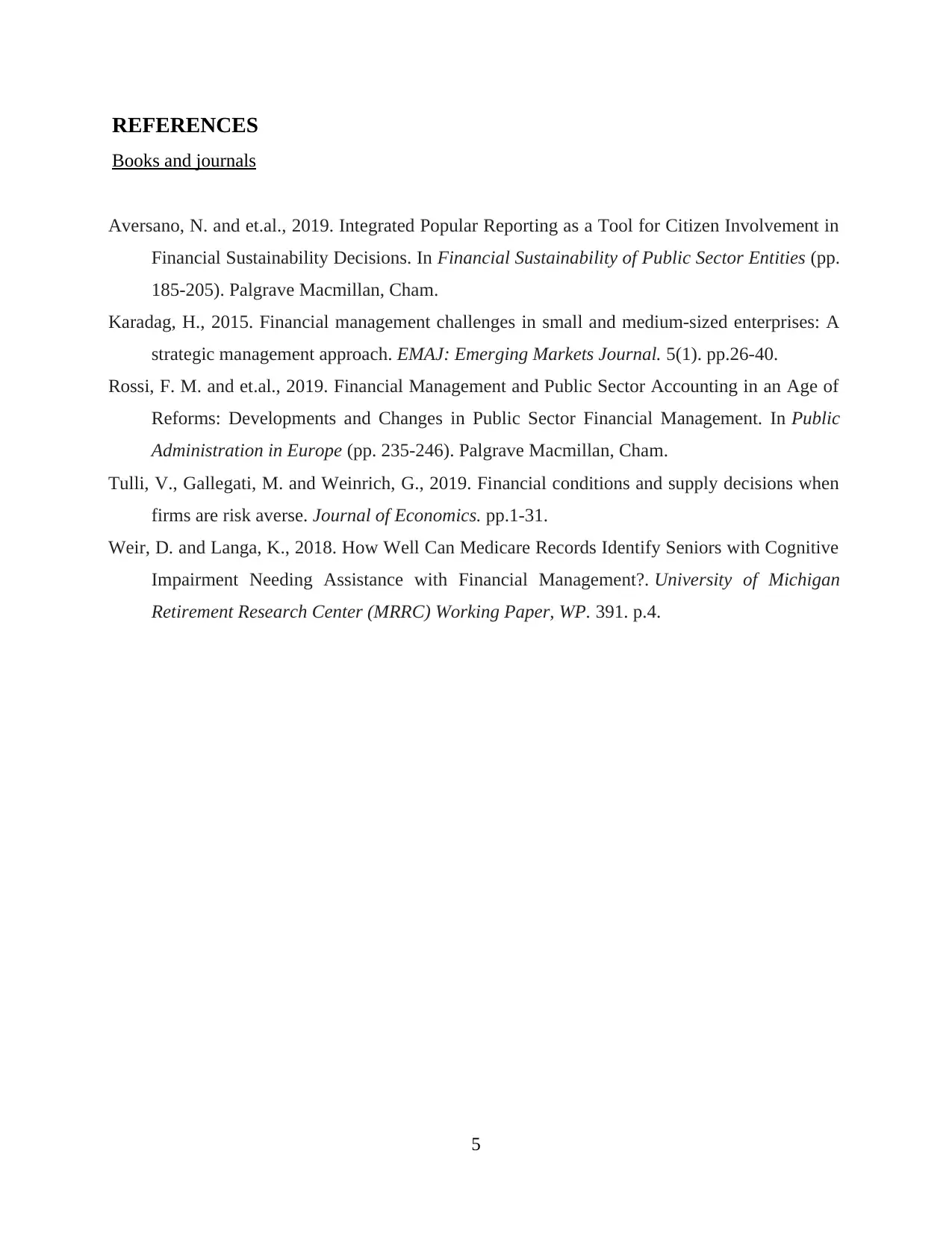
REFERENCES
Books and journals
Aversano, N. and et.al., 2019. Integrated Popular Reporting as a Tool for Citizen Involvement in
Financial Sustainability Decisions. In Financial Sustainability of Public Sector Entities (pp.
185-205). Palgrave Macmillan, Cham.
Karadag, H., 2015. Financial management challenges in small and medium-sized enterprises: A
strategic management approach. EMAJ: Emerging Markets Journal. 5(1). pp.26-40.
Rossi, F. M. and et.al., 2019. Financial Management and Public Sector Accounting in an Age of
Reforms: Developments and Changes in Public Sector Financial Management. In Public
Administration in Europe (pp. 235-246). Palgrave Macmillan, Cham.
Tulli, V., Gallegati, M. and Weinrich, G., 2019. Financial conditions and supply decisions when
firms are risk averse. Journal of Economics. pp.1-31.
Weir, D. and Langa, K., 2018. How Well Can Medicare Records Identify Seniors with Cognitive
Impairment Needing Assistance with Financial Management?. University of Michigan
Retirement Research Center (MRRC) Working Paper, WP. 391. p.4.
5
Books and journals
Aversano, N. and et.al., 2019. Integrated Popular Reporting as a Tool for Citizen Involvement in
Financial Sustainability Decisions. In Financial Sustainability of Public Sector Entities (pp.
185-205). Palgrave Macmillan, Cham.
Karadag, H., 2015. Financial management challenges in small and medium-sized enterprises: A
strategic management approach. EMAJ: Emerging Markets Journal. 5(1). pp.26-40.
Rossi, F. M. and et.al., 2019. Financial Management and Public Sector Accounting in an Age of
Reforms: Developments and Changes in Public Sector Financial Management. In Public
Administration in Europe (pp. 235-246). Palgrave Macmillan, Cham.
Tulli, V., Gallegati, M. and Weinrich, G., 2019. Financial conditions and supply decisions when
firms are risk averse. Journal of Economics. pp.1-31.
Weir, D. and Langa, K., 2018. How Well Can Medicare Records Identify Seniors with Cognitive
Impairment Needing Assistance with Financial Management?. University of Michigan
Retirement Research Center (MRRC) Working Paper, WP. 391. p.4.
5
1 out of 7
Related Documents
Your All-in-One AI-Powered Toolkit for Academic Success.
+13062052269
info@desklib.com
Available 24*7 on WhatsApp / Email
![[object Object]](/_next/static/media/star-bottom.7253800d.svg)
Unlock your academic potential
Copyright © 2020–2025 A2Z Services. All Rights Reserved. Developed and managed by ZUCOL.




